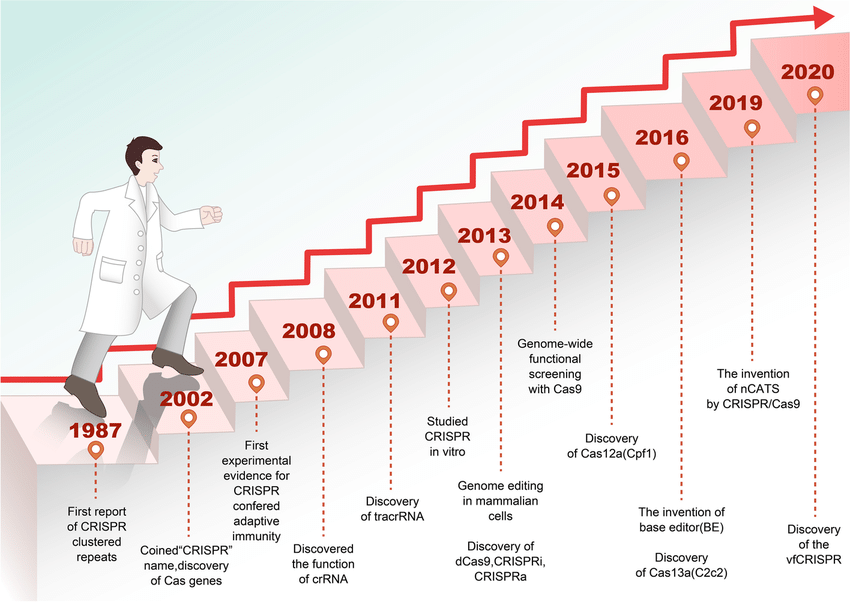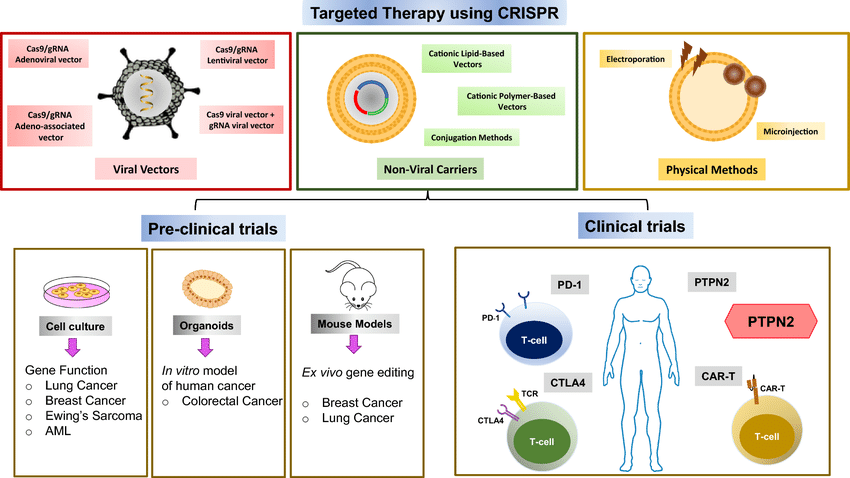Introduction
CRISPR-Cas9 is a recently developed technique for editing genomes with high accuracy. It utilizes a natural defense system found in bacteria and reprograms it to target specific locations in an organism's DNA. This blog post will explore the scientific basis of CRISPR-Cas9, its various applications, and the ongoing advancements and ethical considerations surrounding this powerful tool.
The History & Discovery Of CRISPR
CRISPR-Cas9, a revolutionary genome editing tool, has a surprisingly recent origin story.exclamation Here's a breakdown of its key discoveries:
1. Identifying the Repeats (1987):
- The journey began in 1987 when a Japanese team led by Yoshizumi Ishino accidentally discovered unusual repeating sequences of DNA in E. coli bacteria.
- These repetitive sequences, later named Clustered Regularly Interspaced Short Palindromic Repeats (CRISPR), were interspersed with unique spacer sequences.
- The function of these elements remained unclear at the time.exclamation
2. Unveiling the Bacterial Defense System (2005):
- Fast forward to the early 2000s, with the increasing availability of DNA sequence data, scientists began noticing similar CRISPR sequences across various bacteria and archaea.
- In 2005, independent research groups observed a crucial detail: the spacer sequences within CRISPR arrays often matched snippets of DNA from viruses (bacteriophages) and plasmids that can infect bacteria.
- This led to the hypothesis that CRISPR might be part of a bacterial defense system against invading genetic material.
3. Decoding the Mechanism (2007):
- By 2007, researchers began to understand the complete picture.expand_more CRISPR serves as a memory bank for past infections, while Cas (CRISPR-associated) genes encode proteins responsible for the immune response.
- When a virus infects a bacterium, a small piece of viral DNA gets incorporated into the CRISPR array as a new spacer sequence.
- Upon subsequent infection by the same virus, the cell uses the crRNA ( CRISPR RNA) transcribed from the spacer sequence to recognize and target the viral DNA for destruction by Cas proteins, like Cas9, providing immunity.
4. CRISPR-Cas9 as a Genome Editing Tool (2012):
- Recognizing the potential of this natural targeting system, Jennifer Doudna and Emmanuelle Charpentier published a groundbreaking study in 2012.
- Their work demonstrated how CRISPR-Cas9 could be reprogrammed to target specific locations within any genome, not just viral DNA.
- This marked the birth of CRISPR-Cas9 as a powerful and versatile tool for genome editing.
Continuing Advancements:
The discovery and development of CRISPR-Cas9 is an ongoing process.expand_more Scientists are constantly working to improve its efficiency, specificity, and delivery methods to unlock its full potential in various fields.
The CRISPR-Cas9 System
CRISPR-Cas9 functions through two key components:
Cas9 protein
This molecule acts as a precise DNA cutting tool
Guide RNA (gRNA)
This molecule guides Cas9 to the exact location in the genome where the cut needs to be made.
The gRNA is engineered to match the desired target DNA sequence. When the gRNA binds to its target, Cas9 creates a clean cut at that specific location. The cell's natural repair mechanisms then attempt to fix the break, which creates an opportunity for researchers to introduce specific changes to the DNA.
Applications of CRISPR-Cas9
The versatility of CRISPR-Cas9 has opened doors to a wide range of applications in various scientific fields:
- Gene Therapy: By correcting or replacing faulty genes, CRISPR-Cas9 has the potential to treat genetic diseases.
- Functional Genomics: Researchers can use CRISPR-Cas9 to inactivate specific genes to understand their role in an organism.
- Drug Discovery: CRISPR-Cas9 can be used to create cell models of diseases, which can aid in developing new therapeutic strategies.
- Agriculture: Precise genome editing can lead to the development of crops with improved yield, disease resistance, and nutritional value.
Advancements and Considerations
Research on CRISPR-Cas9 is ongoing, with a focus on 3 main factors described below:
As research progresses, we can expect to see a wider range of CRISPR-based products emerge in various fields including those from GENTAUR .
Enhancing Efficiency and Specificity
Minimizing unintended cuts in the DNA (off-target effects) is an important area of research.
Delivery Methods:
Developing safe and efficient methods for delivering CRISPR-Cas9 components into target cells is crucial for therapeutic applications.
Ethical Considerations:
The potential implications of editing human egg or sperm cells (germline editing) raise significant ethical concerns that require careful discussion.
Conclusion
CRISPR-Cas9 is a powerful tool that has revolutionized various scientific fields. As research continues to improve its applications and address ethical considerations, CRISPR-Cas9 promises to play a significant role in future advancements in gene editing and therapeutic strategies.
For a deeper dive into CRISPR-Cas9 technology, watch the video below:

